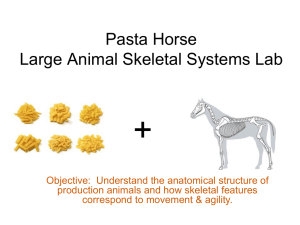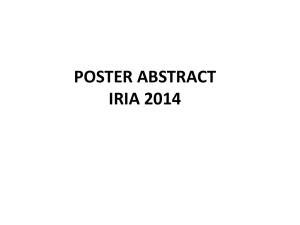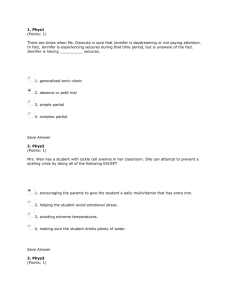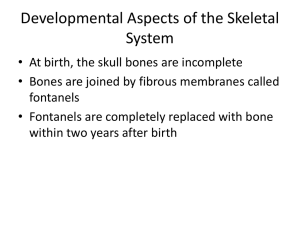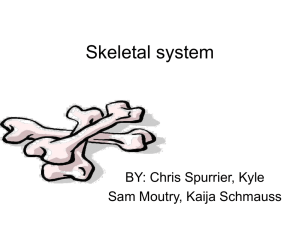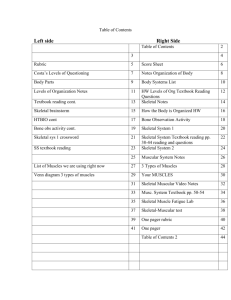Anatomical System Analysis-The Skeletal System
advertisement
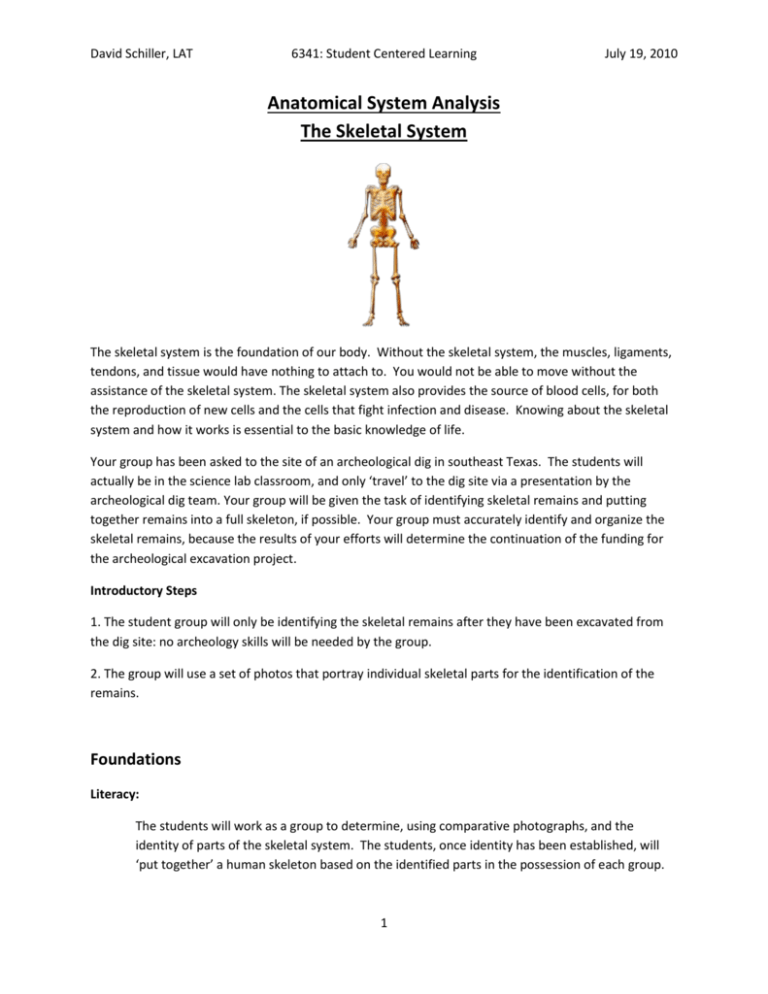
David Schiller, LAT 6341: Student Centered Learning July 19, 2010 Anatomical System Analysis The Skeletal System The skeletal system is the foundation of our body. Without the skeletal system, the muscles, ligaments, tendons, and tissue would have nothing to attach to. You would not be able to move without the assistance of the skeletal system. The skeletal system also provides the source of blood cells, for both the reproduction of new cells and the cells that fight infection and disease. Knowing about the skeletal system and how it works is essential to the basic knowledge of life. Your group has been asked to the site of an archeological dig in southeast Texas. The students will actually be in the science lab classroom, and only ‘travel’ to the dig site via a presentation by the archeological dig team. Your group will be given the task of identifying skeletal remains and putting together remains into a full skeleton, if possible. Your group must accurately identify and organize the skeletal remains, because the results of your efforts will determine the continuation of the funding for the archeological excavation project. Introductory Steps 1. The student group will only be identifying the skeletal remains after they have been excavated from the dig site: no archeology skills will be needed by the group. 2. The group will use a set of photos that portray individual skeletal parts for the identification of the remains. Foundations Literacy: The students will work as a group to determine, using comparative photographs, and the identity of parts of the skeletal system. The students, once identity has been established, will ‘put together’ a human skeleton based on the identified parts in the possession of each group. 1 David Schiller, LAT 6341: Student Centered Learning July 19, 2010 The students will use their ability to analyze, compare and contrast, and collaborate to reach a correct solution to the problem. Problem-Solving: Organizing Problem: The problem that will anchor this design will be, “Can you identify the skeletal remains based on photographic matching to determine type of bone and where it fits into the skeletal system?” General Problem Solving Strategies: analyze, compare, contrast, identify selection, collaboration, and the use of deductive reasoning. Knowledge: Structures: Students will need to possess the ability to analyze and compare based on photographic evidence and the ‘real’ skeletal bone. They must able to use visual evidence to determine bone structure and anatomical differences. Discourse: The archeological team will give a presentation on how they identify skeletal remains at a dig site. This will allow students to see a ‘hands-on’ presentation of how professionals in the field determine the identity of skeletal remains. Using Information: Community: The group will have different team members whose roles will be determined by the group itself; each student will assume each different role during the lesson. Communication among group members will be essential. Activities Authentic Activities: Video Presentation: The archeological dig team will be presenting, via YouTube video, how they work as a group/team to determine the identity of skeletal remains. Background Building Activities: Prior to the lab lesson on the identifying of skeletal remains, the students will have experienced several lecture and activity lessons on identifying skeletal remains by using photographs, and other means of identification. Constructing Activities: After the lesson, activities will be constructed for the students to use their analyzing skills in other human body systems discussions, and lessons. The other body systems can be analyzed 2 David Schiller, LAT 6341: Student Centered Learning July 19, 2010 similarly using analysis, compare/contrast, inductive/deductive reasoning, and collaboration. The TEKS for Anatomy and Physiology are based on comparative skill building for the systems of the human body. Contents Contents: TEKS: Texas Essential Knowledge and Skills §121.13. Anatomy and Physiology of Human Systems (One Science Credit). (a) General requirements. The prerequisites for this course are Biology and Chemistry. To receive credit in science, students must meet the 40% laboratory and fieldwork requirement identified in §74.3(b)(2)(C) of this title (relating to Description of a Required Secondary Curriculum). This course is recommended for students in Grade 11 or 12. (b) Introduction. (1) Science is a way of learning about the natural world. Students should know how science has built a vast body of changing and increasing knowledge described by physical, mathematical, and conceptual models, and that science may not answer all questions. (2) A system is a collection of cycles, structures, and processes that interact. Students should understand a whole in terms of its components and how these components relate to each other and to the whole. All systems have basic properties that can be described in terms of space, time, energy and matter. Change and constancy occur in systems and can be observed and measured as patterns. These patterns help to predict what will happen next and can change over time. (3) Investigations are used to learn about the natural world through questioning, observing and drawing conclusions. Students should understand that certain types of questions can be answered by investigations, and that conclusions and models built from these investigations change as new observations are made. Models of objects and events are tools for understanding the natural world and can show how systems work. They have limitations and, based on new discoveries, are constantly being changed to more closely reflect the physical world. (c) Knowledge and skills. (1) The student conducts laboratory investigations and fieldwork using safe, environmentally appropriate, and ethical practices. The student is expected to: (A) demonstrate safe practices during laboratory investigations and in fieldwork; and (B) make wise choices in the conservation and use of resources and the disposal of materials. (2) The student uses scientific methods during fieldwork and laboratory investigations. The student is expected to: (A) plan and implement investigative procedures including asking questions, formulating testable hypotheses, and selecting equipment and technology; (B) make observations and measurements in collecting data in various ways; 3 David Schiller, LAT 6341: Student Centered Learning July 19, 2010 (C) organize, analyze, evaluate, make inferences, and predict trends from data; and (D) communicate valid conclusions. (3) The student uses critical thinking and scientific problem solving to make informed decisions. The student is expected to: (A) analyze, review, and critique hypotheses and theories as to their strengths and weaknesses using scientific evidence and information; (B) make choices in selecting everyday products using scientific research findings; (C) evaluate the impact of research on scientific thought, society, and the environment; (D) gather information about future careers using a variety of sources; and (E) research and describe the history of science and contributions of scientists. (10) The student knows how to compare anatomical structures to physiological functions. The student is expected to: (A) analyze the relationships between the anatomical structures and physiological functions of systems such as integumentary, reproductive, nervous, and digestive; (B) evaluate the cause and effect of disease, trauma and congenital defects on the structure and function of cells, tissues, organs, and systems; (C) research and evaluate technological advances and limitations in the treatment of system disorders; and (D) identify characteristics of the aging process on body systems. Source: The provisions of this §121.13 adopted to be effective September 1, 1998, 22 TexReg 5014. Tools Tools: The tools to be utilized for this lesson are the internet, photographs of the skeletal system, and YouTube video of the presentation of the archeological team. Systems of Assessment Assessments: Rubric: A rubric will be developed to determine the degree to which the student(s) correctly identified the parts of the skeletal system. The rubric must take into account the level of analysis 4 David Schiller, LAT 6341: Student Centered Learning July 19, 2010 needed to determine the identity of certain skeletal system structures and the students’ ability and effort to grade accordingly. Learning Environment Environment: The learning environment will be a science lab classroom. Each class of 30 students will be divided into groups of 5 students for this lesson. The classroom will also be equipped with a projector and screen, so that the groups of students can watch the presentation by the archeological team. To Do To Do List: 1. Determine the identity of the skeletal remains 2. Assemble a full skeleton, if possible; Are the right types and numbers of bones available? 5
